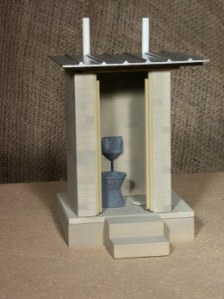Durban — It might seem unusual for a waste utility to be concerned with the goal of ending world hunger, but that’s part of the mission of the Water and Sanitation department in South Africa’s second largest city of Durban. AllAfrica’s Julie Frederikse spoke with Neil MacLeod, who heads this department for the municipality known by its Zulu name, eThekwini.
“Intensive agriculture requires fertilizers, whose main component is phosphorus, yet where does our phosphorus go after it goes into crops and is digested?” said eThekwini Municipality Water and Sanitation director Neil MacLeod. “Into a toilet. And then it goes into a treatment works, then into a river, and it gets washed into the sea.” 
With an estimated 30 percent of household water used to flush Durban’s toilets – water which the city has paid to pump and purify – MacLeod sees flushing toilets as unsustainable technology. Like much of Africa, South Africa is water-scarce, with water restrictions expected soon for this city of 3.7 million, whose population is swelling by some 150,000 people per year.
MacLeod sees salvation in an alternative toilet that uses no water at all. Called the Urine Diverting (UD) toilet, it separates urine from faeces so that nutrients can be recovered and returned to the earth. Nitrogen, potassium and phosphorus – aka NPK 5:3:1 – is an excellent fertilizer for growing vegetables.
Africa’s busiest port city started installing UD toilets in 2003. Some 70,000 are now in use in all its outlying areas. One of the largest dry toilet schemes in the world, eThekwini municipality’s effort is seen as offering a potentially replicable and sustainable sanitation model for municipalities elsewhere in Africa.
Backed by a four-year U.S.$3-million grant from the Bill & Melinda Gates Foundation, the city of Durban has started to harvest the urine from its UD toilets. Nutrients are being extracted with technical assistance from the Swiss Federal Institute of Aquatic Science and Technology (Eawag).
“Now we’re doing the research to see how we can turn the collection of urine into a business,” MacLeod explained. The city has found entrepreneurs who are prepared to remove the urine for processing. Efforts are underway to take small businesses to scale, as job creation is desperately needed in this city where about 40 percent of the population earns less than $2 a day.
Other areas that Durban’s sanitation project aims to research include finding ways to recycle sewage water, to grow algae in treated water and to use the biodegradable contents of waste to generate energy. “Then we solve our three problems,” concludes MacLeod. “We have sustainable water, agriculture and energy. You see how waste is the key to a sustainable future for developing countries? So treat it as a valuable thing, and not something nasty.”
Overcoming the nasty part remains a challenge. AllAfrica spoke to some residents of the informal settlements that are home to an estimated 900,000 people in eThekwini municipality to find out their views on dry toilets.
Agnes Mthethwa, 37, a domestic worker, had not heard about plans to build dry toilets from the ward councilor who represents her area. She uses a pit latrine outside the shack where she lives in Bester Camp, near the mainly Indian and African township of Phoenix, and says the municipality doesn’t care enough about people in the informal settlements.
Zwelibabanzi Ntombela, 42, was also unaware of the new sanitation plans.
“I haven’t heard about dry toilets, but it doesn’t sound like they would be suitable for people like us,” she said. “Maybe it’s something for people in rural areas.” Now that he found a training position with the city’s transport department, he has installed a flushing toilet in his house in Inanda Newtown township, on the outskirts of Durban.
Community leader Thembinkosi Qumbela, 45, uses communal ablutions and toilets in the Mayville shack settlement where he lives, just a few kilometers from the city centre. For him: “Toilets are not about saving water – they’re about the dignity of people living in informal settlements.”
Water and Sanitation head McLeod knows that these are the kinds of attitudes that eThekwini municipality will have to overcome. That’s why his department’s outreach goal is “how to make dry toilets sexy”.
“The flushing toilet was invented in 1860, for Queen Victoria, and we use practically the same toilets today,” says MacLeod. “If I gave you a cellphone that was made in 1980, you’d say, ‘I don’t want that thing, I want a Blackberry, or a Nokia or a smartphone,’ because the technology has advanced. So I want you to see a flushing toilet like the cellphone of 1980: clumsy, wasteful, not very clever.”
“I actually said to Bill Gates: ‘Bill, when you have a dry toilet in your $100-million dollar house, then I will have succeeded.’ I can say, ‘Even Bill Gates has a dry toilet in his house – it’s the toilet of the future’.”





